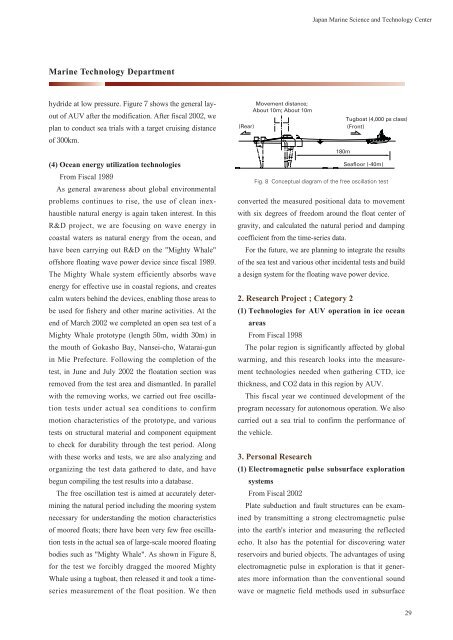Marine Ecosystems Research Department - jamstec japan agency ...
Marine Ecosystems Research Department - jamstec japan agency ...
Marine Ecosystems Research Department - jamstec japan agency ...
Create successful ePaper yourself
Turn your PDF publications into a flip-book with our unique Google optimized e-Paper software.
Japan <strong>Marine</strong> Science and Technology Center<br />
<strong>Marine</strong> Technology <strong>Department</strong><br />
hydride at low pressure. Figure shows the general layout<br />
of AUV after the modification. After fiscal , we<br />
plan to conduct sea trials with a target cruising distance<br />
of km.<br />
(4) Ocean energy utilization technologies<br />
From Fiscal <br />
As general awareness about global environmental<br />
problems continues to rise, the use of clean inexhaustible<br />
natural energy is again taken interest. In this<br />
R&D project, we are focusing on wave energy in<br />
coastal waters as natural energy from the ocean, and<br />
have been carrying out R&D on the "Mighty Whale"<br />
offshore floating wave power device since fiscal .<br />
The Mighty Whale system efficiently absorbs wave<br />
energy for effective use in coastal regions, and creates<br />
calm waters behind the devices, enabling those areas to<br />
be used for fishery and other marine activities. At the<br />
end of March we completed an open sea test of a<br />
Mighty Whale prototype (length m, width m) in<br />
the mouth of Gokasho Bay, Nansei-cho, Watarai-gun<br />
in Mie Prefecture. Following the completion of the<br />
test, in June and July the floatation section was<br />
removed from the test area and dismantled. In parallel<br />
with the removing works, we carried out free oscillation<br />
tests under actual sea conditions to confirm<br />
motion characteristics of the prototype, and various<br />
tests on structural material and component equipment<br />
to check for durability through the test period. Along<br />
with these works and tests, we are also analyzing and<br />
organizing the test data gathered to date, and have<br />
begun compiling the test results into a database.<br />
The free oscillation test is aimed at accurately determining<br />
the natural period including the mooring system<br />
necessary for understanding the motion characteristics<br />
of moored floats; there have been very few free oscillation<br />
tests in the actual sea of large-scale moored floating<br />
bodies such as "Mighty Whale". As shown in Figure ,<br />
for the test we forcibly dragged the moored Mighty<br />
Whale using a tugboat, then released it and took a timeseries<br />
measurement of the float position. We then<br />
(Rear)<br />
Movement distance;<br />
About 10m; About 10m<br />
converted the measured positional data to movement<br />
with six degrees of freedom around the float center of<br />
gravity, and calculated the natural period and damping<br />
coefficient from the time-series data.<br />
For the future, we are planning to integrate the results<br />
of the sea test and various other incidental tests and build<br />
a design system for the floating wave power device.<br />
2. <strong>Research</strong> Project ; Category 2<br />
(1) Technologies for AUV operation in ice ocean<br />
areas<br />
From Fiscal <br />
The polar region is significantly affected by global<br />
warming, and this research looks into the measurement<br />
technologies needed when gathering CTD, ice<br />
thickness, and CO data in this region by AUV.<br />
This fiscal year we continued development of the<br />
program necessary for autonomous operation. We also<br />
carried out a sea trial to confirm the performance of<br />
the vehicle.<br />
3. Personal <strong>Research</strong><br />
(1) Electromagnetic pulse subsurface exploration<br />
systems<br />
From Fiscal <br />
180m<br />
Tugboat (4,000 ps class)<br />
(Front)<br />
Seafloor (-40m)<br />
Fig. 8 Conceptual diagram of the free oscillation test<br />
Plate subduction and fault structures can be examined<br />
by transmitting a strong electromagnetic pulse<br />
into the earth's interior and measuring the reflected<br />
echo. It also has the potential for discovering water<br />
reservoirs and buried objects. The advantages of using<br />
electromagnetic pulse in exploration is that it generates<br />
more information than the conventional sound<br />
wave or magnetic field methods used in subsurface<br />
29
















